Related Research Articles

Alphonse Milne-Edwards was a French mammalologist, ornithologist and carcinologist. He was English in origin, the son of Henri Milne-Edwards and grandson of Bryan Edwards, a Jamaican planter who settled at Bruges.
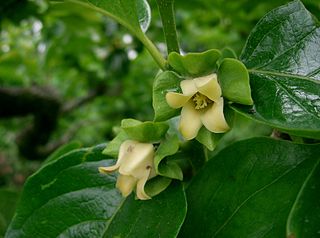
Diospyros is a genus of over 700 species of deciduous and evergreen trees and shrubs. The majority are native to the tropics, with only a few species extending into temperate regions. Individual species valued for their hard, heavy, dark timber, are commonly known as ebony trees, while others are valued for their fruit and known as persimmon trees. Some are useful as ornamentals and many are of local ecological importance. Species of this genus are generally dioecious, with separate male and female plants.

Palaquium is a genus of about 120 species of trees in the family Sapotaceae. Their range is from India across Southeast Asia, Malesia, Papuasia and Australasia, to the western Pacific Islands.
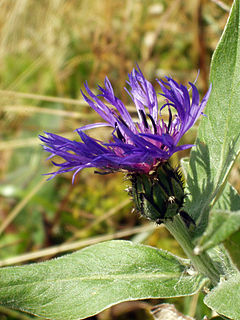
Centaurea montana, the perennial cornflower, mountain cornflower, bachelor's button, montane knapweed or mountain bluet, is a species of flowering plant in the daisy family Asteraceae, endemic to Europe. It is widespread and common in the more southerly mountain ranges of Europe, but is rarer in the north. It escapes from gardens readily, and has thereby become established in the British Isles, Scandinavia and North America.

Thermopsis montana, the false lupin, mountain goldenbanner, golden pea, mountain thermopsis, or revonpapu, is a plant species which is native of the western United States. The Latin specific epithet montana refers to mountains or coming from mountains.
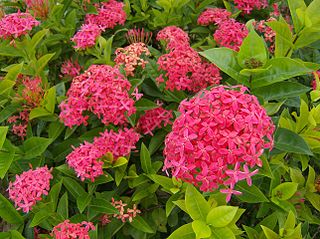
Ixora is a genus of flowering plants in the family Rubiaceae. It is the only genus in the tribe Ixoreae. It consists of tropical evergreen trees and shrubs and holds around 562 species. Though native to the tropical and subtropical areas throughout the world, its centre of diversity is in Tropical Asia. Ixora also grows commonly in subtropical climates in the United States, such as Florida where it is commonly known as West Indian jasmine. Other common names include viruchi, rangan, kheme, ponna, chann tanea, techi, pan, siantan, jarum-jarum/jejarum, jungle flame, jungle geranium, and cruz de Malta, among others. The plants possess leathery leaves, ranging from 3 to 6 inches in length, and produce large clusters of tiny flowers in the summer. Members of Ixora prefer acidic soil, and are suitable choices for bonsai. It is also a popular choice for hedges in parts of South East Asia. In tropical climates they flower year round and are commonly used in Hindu worship, as well as in ayurveda and Indian folk medicine.
Heliciopsis montana is a species of plant in the family Proteaceae. It is a tree endemic to Peninsular Malaysia. It is threatened by habitat loss. The Latin specific epithet montana refers to mountains or coming from mountains.

Isonandra is a genus of plants in the family Sapotaceae found in tropical Asia, described as a genus in 1840.

Madhuca is a genus of plants in the family Sapotaceae first described as a genus in 1791.
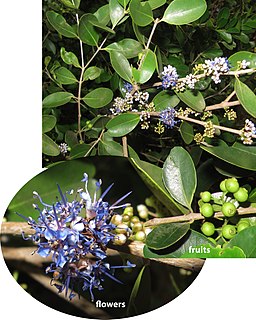
Memecylon is a plant group in Melastomataceae. It consists of 350-400 species of small to medium-sized trees and shrubs occurring in the Old World tropics. Memecylon is a monophyletic group basal to the Melastomataceae clade. Memecylon taxa have more than 600 published basionyms. Diversity of this group is concentrated in tropical Africa, Madagascar, Sri Lanka, India and Malaysia.

Clematis montana is a flowering plant in the buttercup family Ranunculaceae. A vigorous deciduous climber, in late spring it is covered with a mass of small blooms for a period of about four weeks. The flowers are white or pink, four-petalled, with prominent yellow anthers. It is native to mountain areas of Asia from Afghanistan to Taiwan.

Bellendena montana, commonly known as mountain rocket, is a species of low-growing multi-stemmed shrub in the plant family Proteaceae. It is endemic to high-altitude subalpine and alpine regions in Tasmania, Australia. The prominent white flower spikes appear over summer, followed by small bright red or yellow fruit in late summer and autumn.
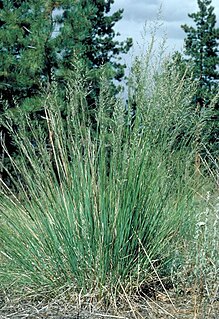
Muhlenbergia montana, the mountain muhly, is a species of grass. It is native to North and Central America, where it is found throughout the Western United States, the Sierra Nevada, Mexico, and Guatemala.

Acacia montana, commonly known as mallee wattle, is a shrub species endemic to south-eastern Australia. The species was first formally described in 1842 by English botanist George Bentham from plant material collected from the "highlands near the Liverpool Plains" in New South Wales. The Latin specific epithet montana refers to mountains or coming from mountains.
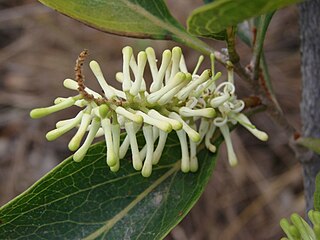
Roupala montana is a species of shrub or tree in the family Proteaceae which is native to much of the Neotropics. It is a morphologically variable species with four recognised varieties. The species is used medicinally in Venezuela, and as an aphrodisiac in Trinidad and Tobago and Venezuela.

Carnarvonia is a flowering plant genus of a single species, commonly named red oak or red silky oak and constituting part of the plant family Proteaceae. The single species named Carnarvonia araliifolia grows to large trees of 30 m (100 ft) or more. They grow naturally only (endemic) to the Wet Tropics rainforests region of north-eastern Queensland, Australia. The species has two described varieties, C. araliifolia var. araliifolia and C. araliifolia var. montana, and the common names are used for both.
Isonandra lanceolata is a plant in the family Sapotaceae. The specific epithet lanceolata means "spear-shaped", referring to the leaves.
I. montana may refer to:
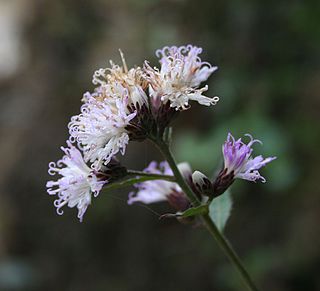
Acilepis is a genus of Asian plants in the Vernonieae within the daisy family.
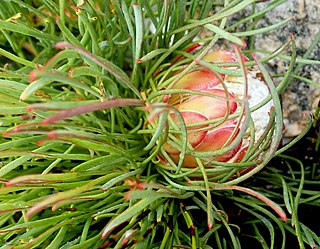
Protea montana also known as the Swartberg sugarbush, is a flowering plant of the genus Protea within the family Proteaceae, which is endemic to the southwestern Cape Region of South Africa. In Afrikaans it is known as swartbergsuikerbos.
References
- 1 2 Kew World Checklist of Selected Plant Families
- ↑ Thwaites, George Henry Kendrick. 1860. Enumeratio Plantarum Zeylaniae 177-178 description in Latin, commentary in English
- ↑ Tropicos, Isonandra montana (Thwaites) Gamble
- ↑ Vascular Plant Image Library, Texas Higher Education Coordinating Board, Isonandra montana (Thw.) Gamble - Sapotaceae
- ↑ Archibald William Smith A Gardener's Handbook of Plant Names: Their Meanings and Origins , p. 239, at Google Books